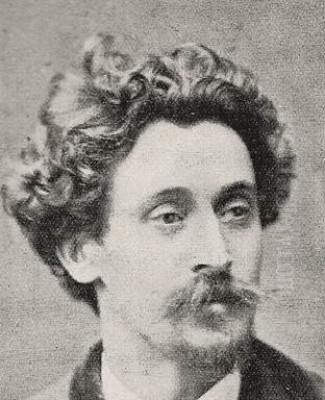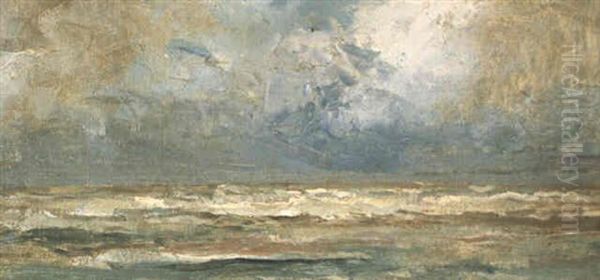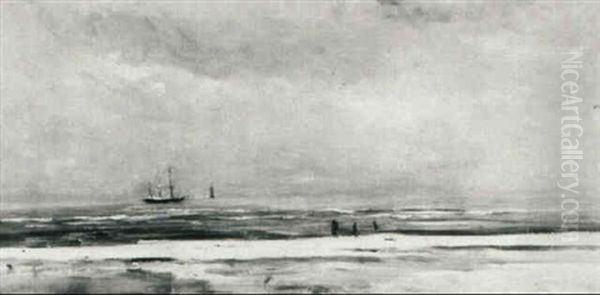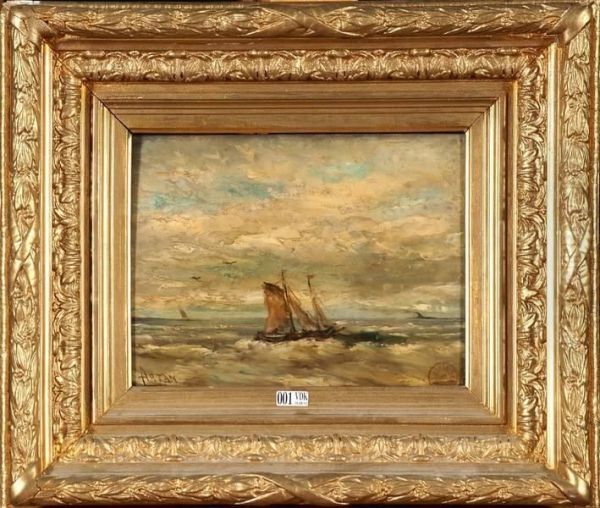
Louis Artan de Saint-Martin stands as a pivotal figure in 19th-century Belgian art, celebrated primarily for his evocative and atmospheric marine paintings. Often associated with Realism and the burgeoning Impressionist movement, Artan carved a unique niche for himself, capturing the raw beauty and often turbulent moods of the North Sea. His work provides a vital link between the academic traditions he reacted against and the modern approaches to light and landscape that would define the era. It is essential, however, to distinguish him clearly from his namesake, the French philosopher and mystic Louis Claude de Saint-Martin (1743-1803), whose life and work belong to an entirely different domain. The painter, Louis Artan, lived from 1837 to 1890, dedicating his artistic life to the sea.
Early Life and Artistic Beginnings
Born Louis Marie Émile Artan in The Hague on April 20, 1837, he hailed from a noble family; his father was an army officer who served as an aide-de-camp to Prince Frederick of the Netherlands. Following his father's death in 1842, the family moved frequently, eventually settling in Brussels. Artan initially pursued a military career, serving in the Belgian army for about six years until 1864. However, his passion lay elsewhere.
Unlike many artists of his time who followed a structured academic path, Artan was largely self-taught. His decision to dedicate himself fully to painting came relatively later in life. He began exhibiting his work in the mid-1860s. His early artistic explorations took him to the rugged landscapes of Brittany and the diverse terrains of the Netherlands, regions known for inspiring landscape and marine painters. These travels were formative, exposing him to different light conditions and coastal environments that would become central to his oeuvre.
His initial works showed an inclination towards landscape painting, but it was the sea, particularly the North Sea bordering Belgium and the Netherlands, that truly captured his artistic imagination. This focus would dominate his career, leading him to become one of Belgium's foremost marine painters. His independent spirit and lack of formal academic training perhaps allowed him a greater freedom to experiment and develop a personal style responsive to direct observation.
Parisian Influences: Courbet and Corot

A significant turning point in Artan's artistic development occurred during his time spent in Paris between 1867 and 1868. There, he encountered the work and possibly the persons of leading figures in French Realism and the Barbizon School. The impact of Gustave Courbet, the uncompromising champion of Realism, was profound. Courbet's bold technique, often employing the palette knife, and his commitment to depicting the tangible reality of the world, resonated with Artan.
Equally important was the influence of Jean-Baptiste Camille Corot. While known for his poetic landscapes imbued with soft light, Corot was also a master observer of nature and atmosphere. His ability to capture subtle tonal variations and the feeling of a specific time and place likely encouraged Artan's own sensitivity to light and atmospheric effects. The Barbizon painters, including figures like Charles-François Daubigny, known for his river scenes painted from his studio boat, and Théodore Rousseau, also emphasized direct observation and painting en plein air (outdoors), principles Artan increasingly embraced.
These encounters solidified Artan's move away from romanticized or purely picturesque depictions towards a more direct, robust, and often dramatic portrayal of nature. He became particularly interested in capturing the transient effects of light on water and sky, a pursuit that aligned him with the emerging concerns of Impressionism, even as his grounding remained firmly within the Realist ethos. Other French artists like Eugène Boudin, famous for his beach scenes and luminous skies of Normandy, were also exploring similar themes, contributing to a broader European shift in landscape and marine art.
The Société Libre des Beaux-Arts
Upon returning to Belgium, Artan became a key figure in the Brussels art scene, which was experiencing its own push towards modernity. In 1868, he was a founding member of the Société Libre des Beaux-Arts (Free Society of Fine Arts). This association was established as a reaction against the conservative standards and jury system of the official Brussels Salon and the prevailing academic art establishment.
The Société Libre aimed to promote artistic freedom and championed Realism and Naturalism. It provided a platform for artists who sought to depict contemporary life and landscape with greater truthfulness and individuality. Artan found himself among like-minded Belgian artists who shared a commitment to modern approaches. Fellow members included prominent figures such as Félicien Rops, known for his Symbolist and often provocative works, the sculptor and painter Constantin Meunier, celebrated for his depictions of industrial workers, and landscape painters like Théodore Baron and Alfred Verwee.

Charles Hermans, another influential member, gained fame with his large-scale painting At Dawn, depicting working-class individuals after a night of revelry, a prime example of social realism. The Société Libre organized its own independent exhibitions, allowing artists like Artan to showcase works that might have been rejected by the official Salon. This collective spirit fostered innovation and helped establish Realism as a major force in Belgian art. Artan's participation underscored his commitment to artistic independence and his alignment with the progressive movements of his time.
Master of the Marine: The North Sea Muse
Louis Artan de Saint-Martin's name became synonymous with powerful depictions of the North Sea. He dedicated much of his career to capturing its varied moods, from tranquil calms under vast skies to the dramatic fury of storms lashing the Belgian coast. He often worked directly from nature, setting up his easel on the beaches of Blankenberge, Heist, or Knokke, or observing the sea from the piers and harbours.
His subjects frequently included fishing boats battling rough waves, shipwrecks pounded by surf, vast expanses of water under changing skies, and the wet, reflective sands of the shoreline at low tide. He was less interested in topographical accuracy or anecdotal detail than in conveying the elemental power and atmospheric conditions of the sea. His paintings often evoke a sense of solitude and the overwhelming force of nature compared to human endeavours.
Artan developed a distinctive technique suited to his subject matter. He often used vigorous, broad brushstrokes, sometimes applying paint thickly (impasto) or using a palette knife, reminiscent of Courbet, to convey the texture of waves, clouds, and sand. His palette could range from somber greys, greens, and blues, capturing the often-overcast skies and turbulent waters of the North Sea, to moments of surprising luminosity, depicting sunsets or breaks in the clouds reflecting on the water's surface.
Capturing Light and Atmosphere
A defining characteristic of Artan's art is his profound sensitivity to light and atmosphere. While grounded in Realism's commitment to observation, his approach often bordered on Impressionism in its focus on capturing fleeting moments and the effects of light. He masterfully rendered the damp air, the misty horizons, the play of sunlight on choppy water, and the dramatic contrasts of storm clouds.

His paintings are not merely records of coastal scenes; they are studies in atmospheric conditions. He understood how light behaves differently in various weather situations – the diffused light of a foggy morning, the sharp glare of midday sun on wet sand, the dramatic backlighting of a sunset silhouetting boats against the horizon. This focus aligns him with Impressionists like Claude Monet, who famously studied the changing light on Rouen Cathedral or haystacks. However, Artan's work generally retains a stronger sense of structure and a more tangible, sometimes gritty, realism than mainstream French Impressionism.
His ability to evoke mood through atmosphere is remarkable. Paintings like Calm Sea might convey tranquility and vastness, while works depicting storms possess a raw energy and drama. He often favoured scenes at dawn, dusk, or during unsettled weather, times when light is most dynamic and evocative. This focus on the ephemeral qualities of nature places him as a precursor to later developments in Belgian art, influencing painters like Guillaume Vogels, who also excelled in atmospheric landscapes.
Realism and Evocative Mood
Artan's style is best understood as a form of expressive Realism, deeply influenced by his direct observation of nature but infused with a powerful emotional resonance. He depicted the sea and coast without romantic idealization, showing the harshness of maritime life and the often-unforgiving nature of the sea. Shipwrecks, a recurring theme, were portrayed with a starkness that emphasized the struggle against the elements.
Yet, his realism was not purely objective. His choice of dramatic weather conditions, his emphasis on vast, empty spaces, and his often somber palette contribute to a profound sense of mood, sometimes bordering on melancholy or awe. While not explicitly Symbolist in the manner of Félicien Rops or later artists like James Ensor, Artan's work possesses a suggestive power that transcends mere representation. The sea in his paintings often feels like a living entity, powerful and indifferent.
His technique supported this expressive goal. The visible brushwork, the textured surfaces, and the dynamic compositions all contribute to the immediacy and emotional impact of his scenes. He captured the movement of water and clouds with an energy that makes his paintings feel alive. This blend of truthful observation and subjective interpretation defines his unique contribution to marine painting.
Representative Works and Recognition
Several works stand out in Louis Artan's oeuvre. L'Épave (The Wrecked Ship), exhibited possibly around 1870, is often cited as a key example of his dramatic marine painting. It likely depicted the remnants of a ship battered by the sea, showcasing his ability to convey the power of nature and the vulnerability of man-made structures. Such works cemented his reputation as a powerful interpreter of the coastal environment.

Another notable work is Le Brise-lames (The Mole or Breakwater), an oil painting dating from around 1869, now housed in the Rijksmuseum in Amsterdam. This piece likely exemplifies his interest in coastal structures interacting with the sea, a common theme where the solidity of the mole contrasts with the fluidity and force of the water. His works often carry titles reflecting their direct subject matter, such as High Tide at Blankenberge, Fishing Boats Returning to Harbour, or Sunset over the North Sea.
Artan achieved recognition during his lifetime. He won a gold medal at the Brussels Salon of 1869, ironically an institution whose academic constraints he had sought to challenge through the Société Libre des Beaux-Arts. His success at the Salon indicates the growing acceptance of Realist tendencies, even within official circles. He continued to exhibit regularly in Brussels, Antwerp, and Paris, solidifying his position as a leading Belgian artist. His work was admired for its honesty, vigour, and unparalleled depiction of the North Sea's character.
Later Years and Legacy
Louis Artan de Saint-Martin continued to paint prolifically throughout the 1870s and 1880s, remaining dedicated to his chosen subject matter. He spent considerable time in Blankenberge on the Belgian coast, which became his primary source of inspiration. His later works often show an even greater freedom in brushwork and a heightened sensitivity to atmospheric effects, pushing further towards an Impressionistic rendering of light and colour while retaining his characteristic vigour.
He passed away relatively young, on May 23, 1890, in Nieuwpoort, a coastal town in West Flanders, fittingly close to the sea that had dominated his artistic life. His death occurred just as new artistic movements like Symbolism and Post-Impressionism were gaining momentum in Belgium, with artists like James Ensor exploring radical new directions.
Artan's legacy lies in his position as Belgium's pre-eminent marine painter of the Realist generation. He successfully translated the principles of French Realism, particularly the influence of Courbet, into a distinctly Belgian context, focusing on the unique character of the North Sea coast. His emphasis on direct observation, plein air painting, and capturing atmospheric effects bridged the gap between Realism and Impressionism in Belgium. He influenced subsequent generations of Belgian landscape and marine painters, including Guillaume Vogels and others who continued to explore the expressive potential of light and atmosphere. Today, his works are held in major Belgian museums, including the Royal Museums of Fine Arts of Belgium in Brussels, and internationally, recognized for their powerful evocation of the sea.
Clarifying the Name: Painter vs. Philosopher
It is crucial to reiterate the distinction between Louis Artan de Saint-Martin, the painter (1837-1890), and Louis Claude de Saint-Martin, the philosopher (1743-1803). The latter, known as "le philosophe inconnu" (the unknown philosopher), was a French mystic and writer associated with Martinism. His works, such as Des erreurs et de la vérité (Of Errors and Truth) and Le Ministère de l'Homme-Esprit (The Ministry of the Spirit Man), dealt with esoteric philosophy, theosophy, and critiques of Enlightenment materialism.
The philosopher Louis Claude de Saint-Martin faced controversies related to his unorthodox religious and philosophical ideas, including having his books condemned or banned. These events, his writings, and his association with figures like Martinez de Pasqually belong entirely to his life story and have no connection to the Belgian painter Louis Artan de Saint-Martin. The painter's "controversies," if any, were purely artistic, related to the reception of his Realist style within the context of the 19th-century art world's debates between academicism and modernism. The similarity in names is purely coincidental.
Conclusion: Artan's Enduring Vision
Louis Artan de Saint-Martin remains a significant figure in Belgian art history, primarily remembered for his powerful and atmospheric paintings of the North Sea. As a largely self-taught artist who embraced the tenets of Realism while pioneering techniques sensitive to light and atmosphere, he carved out a unique path. His encounters with Courbet and Corot were formative, but he adapted their influences to his own temperament and his chosen subject: the ever-changing sea bordering his homeland.
A key member of the progressive Société Libre des Beaux-Arts, he championed artistic freedom and contributed significantly to the establishment of modern art in Belgium. His works, characterized by vigorous brushwork, a keen observation of nature, and a remarkable ability to capture mood and atmosphere, stand as enduring testaments to the raw beauty and power of the marine environment. Distinguishing him clearly from the philosopher Louis Claude de Saint-Martin allows for a proper appreciation of Louis Artan's specific contribution as a master painter of the sea, a vital link in the evolution of 19th-century European art.